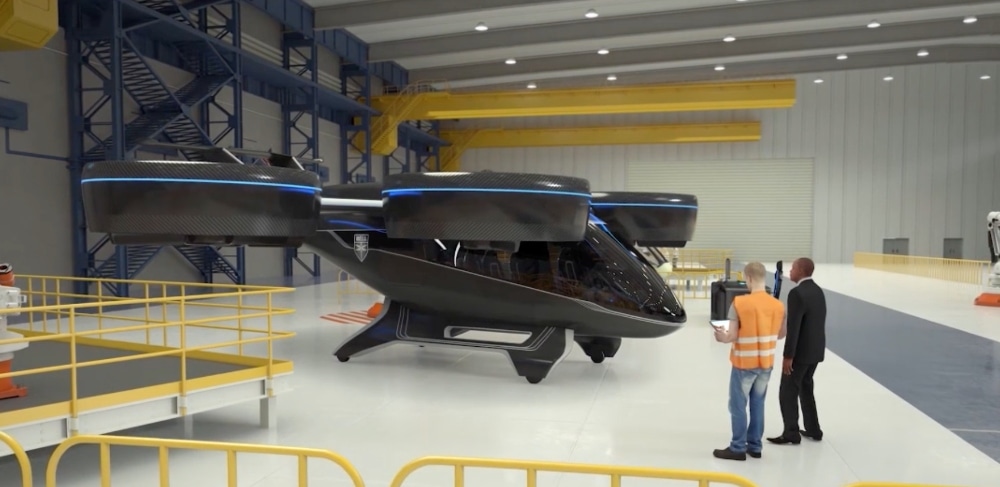NASA Announces State Partnerships to Help Make Drone Taxis and Cargo Drone Delivery a Reality
BY Zacc Dukowitz
27 May 2021NASA recently announced partnerships with five different states to help push forward Advanced Air Mobility (AAM)—that is, to help make drone taxis and cargo drone delivery a reality.

Image credit: NASA
The partnerships will focus on testing and sharing best practices with state and local governments for implementing the use of big drones as air taxis and as cargo delivery vehicles. The five states NASA has partnered with are Florida, Massachusetts, Minnesota, Ohio, and Texas.
[Related read: Lilium, Hyundai, and Airbus Are All Betting Big on Taxi Drones—But When Will They Actually Take Flight?]
All of these state partnerships fall under NASA’s Advanced Air Mobility (AAM) program.
The program has an explicit goal of helping local and state governments leverage new technology—namely drone taxis and cargo delivery drones—to bring services and goods to places that need them in a way that is “equitable, sustainable, and integrated with [their] other transportation systems.”
Here is NASA’s mission statement for AAM:
NASA’s vision for Advanced Air Mobility (AAM) Mission is to help emerging aviation markets to safely develop an air transportation system that moves people and cargo between places previously not served or underserved by aviation—local, regional, intraregional, urban—using revolutionary new aircraft that are only just now becoming possible.
What’s the Difference Between Urban Air Mobility and Advanced Air Mobility?
NASA’s AAM program also includes work on UAM—Urban Air Mobility. So what’s the difference between UAM and AAM?
Both phrases refer to big UAVs like the one pictured below, which could be used either as drone taxis or as cargo drones.

Image credit: NASA
Put simply, the only difference between the two phrases is the location where those big drones will operate.
While UAM refers to using big drones in cities (thus Urban Air Mobility), AAM refers to using big drones basically anywhere but a city.
To help clarify things further, here are definitions of the two phrases:
- UAM. Urban Air Mobility—refers to large unmanned aerial vehicles used primarily as taxi drones or for cargo drone delivery in urban and suburban areas. Learn more on the FAA’s website.
- AAM. Advanced Air Mobility—refers to large unmanned aerial vehicles used in areas that are not urban (basically taking UAM and expanding it to apply to any type of flying environment). Learn more on the FAA’s website.
NASA’s 5 State Drone Taxi / Cargo Drone Partnerships
Here are the five state and local authorities that have partnered with NASA to start planning AAM implementation:
- Florida—The City of Orlando, Florida
- Massachusetts—The Massachusetts Department of Transportation
- Minnesota—The Minnesota Department of Transportation
- Ohio—The Ohio Unmanned Aircraft Systems Center of the Ohio Department of Transportation
- Texas—The North Central Texas Council of Governments Department of Transportation
The goal of these partnerships is for NASA to help each local authority incorporate drone taxis and cargo drone delivery into its civic transportation plan.
As a core part of that effort, NASA AAM plans to host a series of workshops for each partner. The workshops will include other stakeholders in AAM implementation, such as drone taxi manufacturers, airport authorities, and infrastructure providers.
We . . . hope these workshops and any subsequent best practices that are identified will address successful methods for engaging the public in the planning process and generating support for AAM in their communities.
– Nancy Mendonca, Deputy AAM Mission Integration Manager at NASA
The workshops will not only have the aim of providing information to local authorities but also of helping them create policies and approaches for incorporating AAM.
Here are some topics that have been shared for the planned workshops:
- Establishing terms. Identifying a common set of terms for AAM that can be used for discussions, planning, and documentation.
- Vertiport locations. Evaluating potential criteria that could be used in determining locations for“vertiports” (airports for vertical drone taxis).
- Best practices. Developing a “best practice” document around key topics that other states and municipalities could use to help formulate their own AAM plans and policies.
At least four of these workshops are already scheduled for the summer of 2022.

Image credit: NASA
Three AAM Opportunities Released So Far
These new state partnerships were the result of a collaborative opportunity that NASA released in February. The opportunity was open to any state or local government, and was the third such opportunity shared by NASA’s AAM program.

Image credit: NASA
The second opportunity, which was also released in February, was for participants for the first full phase of AAM testing as part of its AAM National Campaign. NASA received several applicants for this opportunity but hasn’t yet announced the final roster.
And the first AAM opportunity NASAS shared publicly was for developmental flight testing partners, which resulted in 17 airspace and vehicle partners signing agreements with NASA.
The five state partnerships NASA announced will focus primarily on sharing information and creating planning documentation.
But they signify a serious step toward a future where you can catch a ride in a drone taxi, or have bulk goods ‘shipped’ through the air in large drones made for carrying freight.
What do you think about the future of AAM? Do you want drone taxis to become a reality or do you have reservations? Share your thought in this thread on the UAV Coach community forum.


